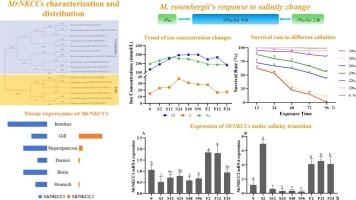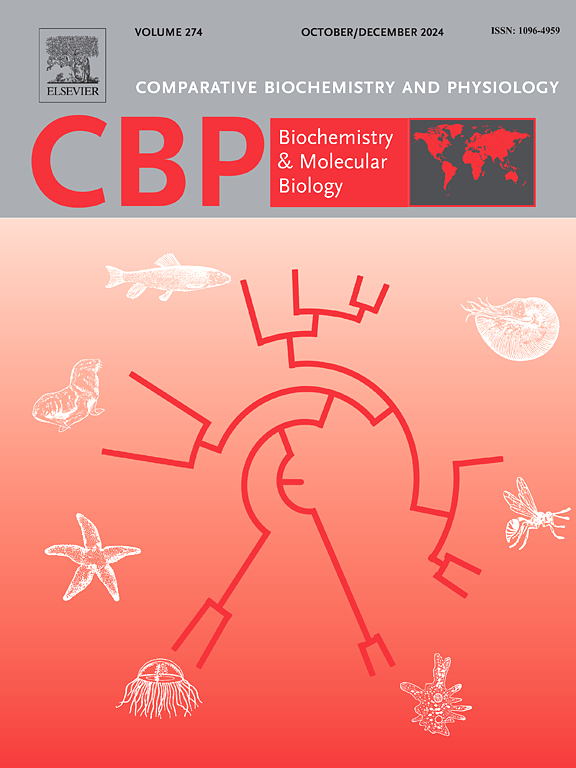Cloning of the Na+-K+-2Cl−(NKCC) transporter in Macrobrachium rosenbergii and its role in osmoregulation
IF 1.8
3区 生物学
Q4 BIOCHEMISTRY & MOLECULAR BIOLOGY
Comparative Biochemistry and Physiology B-Biochemistry & Molecular Biology
Pub Date : 2025-07-03
DOI:10.1016/j.cbpb.2025.111123
引用次数: 0
Abstract
The full-length cDNA sequences of two Na-K-2Cl cotransporter (NKCC) isoforms, MrNKCC1 and MrNKCC2, were identified in Macrobrachium rosenbergii. MrNKCC1 contains a 3183 bp open reading frame (ORF) encoding 1060 amino acids, while MrNKCC2 has a 2679 bp ORF encoding 892 amino acids. Both isoforms share a similar predicted secondary structure, featuring 12 transmembrane domains and a C-terminal, and their amino acid sequences and domain arrangement are highly conserved. Phylogenetic analysis groups fish and crustacean NKCC isoforms into distinct branches, each containing two isoforms. Expression analysis using real-time quantitative PCR (qPCR) revealed distinct tissue distribution patterns. MrNKCC1 was broadly expressed, with the highest levels in the intestine, whereas MrNKCC2 was predominantly found in the gill, hepatopancreas, and epidermis, with peak expression in the gill. To examine their roles in osmoregulation, prawns were exposed to 24 ‰ seawater for 96 h. Hemolymph concentrations of Cl−, K+, and Na+ increased, peaking at 24, 24, and 12 h, respectively. During this period, MrNKCC1 expression was suppressed, while MrNKCC2 expression significantly increased at 2 h after seawater exposure and then returned to initial levels. Gill filaments showed significant histological changes under seawater exposure, including the expansion and proliferation of chloride-secreting cells. Following a 96-h seawater exposure, prawns were transferred to freshwater. This transition led to a decline in plasma Cl−, K+, and Na+ concentrations, accompanied by a marked increase in MrNKCC1 and MrNKCC2 expression. The rapid transcriptional response of both MrNKCC isoforms to salinity fluctuations highlights their critical role in the osmoregulatory mechanisms of M. rosenbergii.

罗氏沼虾Na+-K+-2Cl - (NKCC)转运体的克隆及其在渗透调节中的作用
在罗氏沼虾(Macrobrachium rosenbergii)中鉴定了两个Na-K-2Cl共转运体(NKCC)亚型MrNKCC1和MrNKCC2的全长cDNA序列。MrNKCC1含有3183 bp的开放阅读框(ORF),编码1060个氨基酸,MrNKCC2含有2679 bp的ORF,编码892个氨基酸。两种异构体具有相似的预测二级结构,均具有12个跨膜结构域和一个c -末端,其氨基酸序列和结构域排列高度保守。系统发育分析将鱼类和甲壳类的NKCC亚型分为不同的分支,每个分支包含两个亚型。实时定量PCR (qPCR)表达分析揭示了不同的组织分布模式。MrNKCC1广泛表达,在肠道中表达量最高,而MrNKCC2主要存在于鳃、肝胰腺和表皮中,在鳃中表达量最高。为了研究它们在渗透调节中的作用,将对虾暴露在24‰海水中96 h,血淋巴中Cl−、K+和Na+浓度分别在24、24和12 h达到峰值。在此期间,MrNKCC1的表达受到抑制,而MrNKCC2的表达在海水暴露后2 h显著增加,然后恢复到初始水平。在海水照射下,鳃丝发生了明显的组织学变化,包括分泌氯化物的细胞的扩张和增殖。在海水中暴露96小时后,将对虾转移到淡水中。这种转变导致血浆Cl−、K+和Na+浓度下降,同时MrNKCC1和MrNKCC2表达显著增加。两种MrNKCC亚型对盐度波动的快速转录反应突出了它们在罗氏m.r obergii渗透调节机制中的关键作用。
本文章由计算机程序翻译,如有差异,请以英文原文为准。
求助全文
约1分钟内获得全文
求助全文
来源期刊
CiteScore
4.60
自引率
4.50%
发文量
77
审稿时长
22 days
期刊介绍:
Comparative Biochemistry & Physiology (CBP) publishes papers in comparative, environmental and evolutionary physiology.
Part B: Biochemical and Molecular Biology (CBPB), focuses on biochemical physiology, primarily bioenergetics/energy metabolism, cell biology, cellular stress responses, enzymology, intermediary metabolism, macromolecular structure and function, gene regulation, evolutionary genetics. Most studies focus on biochemical or molecular analyses that have clear ramifications for physiological processes.

 求助内容:
求助内容: 应助结果提醒方式:
应助结果提醒方式:


